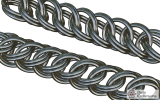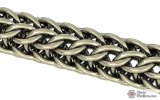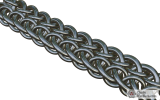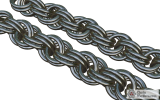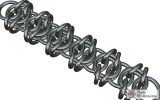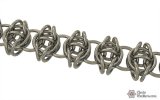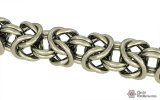What is an Oblique Transformation?
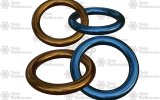 If you've been involved in chain maille for any length of time, you're probably familiar with common variations of weaves such as Nested (aka Scaled) or Stacked (aka Kinged) While it has never been described as such (to my knowledge), Obliquing is a concept that describes a very common occurrence present in many chainmaille weaves. At its most basic, Obliquing is a transformation that results in the creation of a root cell where one did not previously exist. In other words, connecting two rings that were not connected in the unobliqued weave. The closest term used elsewhere would be Mobized or Mobiused - replacing a single ring with a 2 or more ring mobius. While that is a good starting point there are a few differences:
If you've been involved in chain maille for any length of time, you're probably familiar with common variations of weaves such as Nested (aka Scaled) or Stacked (aka Kinged) While it has never been described as such (to my knowledge), Obliquing is a concept that describes a very common occurrence present in many chainmaille weaves. At its most basic, Obliquing is a transformation that results in the creation of a root cell where one did not previously exist. In other words, connecting two rings that were not connected in the unobliqued weave. The closest term used elsewhere would be Mobized or Mobiused - replacing a single ring with a 2 or more ring mobius. While that is a good starting point there are a few differences:- Two connected rings (on this site) are a root cell, not a mobius. A mobius requires 3 or more rings (once again, on this site).
- Obliquing requires that the rings to be obliqued are already present as part of the weave.
- Obliquing is more about connecting two rings that are not usually connected than it is about replacement of a single ring.
- Obliques are never more than 2 rings (without further variation, such as stacking)
- Connecting Obliqued rings to each other makes a 2 in 1 chain
What Can I Do With An Oblique Transformation?
Even though they are only 2 rings, with rotation, there are many appearances that an oblique can take as part of a weave.
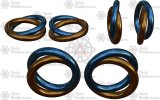
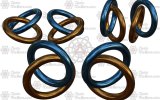
When looking at Obliqued weaves there are a number of common Traits that become apparent. Depending on how the obliques are applied to a weave, there can be multiple traits present. Positioning of the obliqued rings are how the traits are identified.
Traits
AlternateWhen looking at a weave such as Celtic, there is a natural inversion to the edge rings.
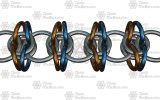
When obliquing, that natural inversion is taken into account when connecting the rings.
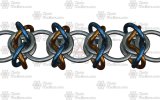
In an Alternate Oblique, the rings are manually manipulated into an unnatural inversion which creates different pairs.
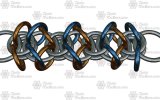
Alternating
Alternating obliques are a sequence when each additional oblique is the opposite position of the previous oblique.
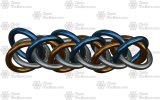
Continuous
Continuous obliques are a sequence when each additional oblique is the same.
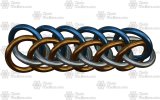
Layered
Layered Obliques are paired. The ring positions present in the obliques are the same, but connected on different edges. Rolling or spinning the sample has no effect upon the structure of the layered oblique (unless using different colors or materials for top and bottom positions...
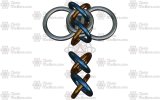
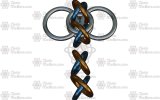
Locked
In a locked oblique, the natural inversion is continued after obliquing and further locked inside another ring.
Starting with an already obliqued weave

Continuation of the inversion and locking
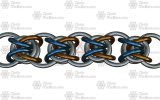
Mirror Lock - Mirror locks are identical. Alternation is made through rotation of the cells.
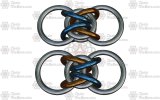
Layered Lock - Directional connection changes must be made between layered locks. Alternation cannot be made through rotation of the cells
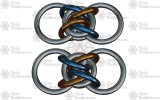
Mirror
Mirror Obliques are paired. The ring positions present in the obliques are mirrored, This changes the color coding on one oblique (when compared to a non-obliqued or layered oblique). In the following render, the blue rings are the top right position, the copper rings are the bottom left position. Rolling the sample changes the sides of the top and bottom positions, making copper rings on the top left position and blue rings on the bottom right.
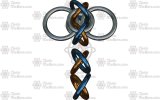
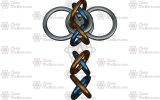
Additional Notes
- Renders for traits (other than continuous & alternating) are shown using terminated weave cells or chain forms. They cannot be translated further without rotation or the addition or removal of rings.
- Alternate Obliques generally need an increase in AR compared to a non-alternate oblique.
- Alternate Locked Obliques are theoretically possible, but more research needs to be done.
Examples of Obliqued Weaves in the Wild
Base Weave:Continuous Oblique - Rose Persian 3 in 1
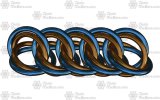
Base Weave:
Continuous Obliques - Full Persian 6 in 1 (Oblique), Full Persian 6 in 1 (Full Oblique) Commonly known as Cross Eyed Persians.
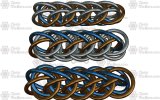
Alternating Obliques - Full Persian 6 in 1 (Oblique Alternating), Full Persian 6 in 1 (Full Oblique Alternating) Commonly known as Cross Eyed Persians Alternating.
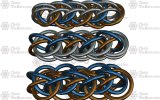
Base Weave:
Continuous Oblique - Slow Worm
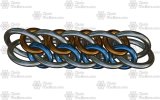
Base Weave:
Continuous Oblique - Mobius Spiral
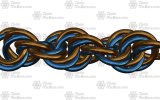
Base Weave:
Continuous Layered Lock Oblique - Barbed Celtic Commonly known as Barbed Helm
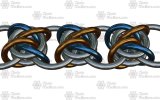
Alternating Layered Lock Oblique - Barbed Celtic (Alternating)
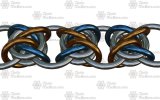
Alternating Mirror Lock Oblique - Bipolar Beestings
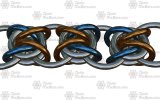
Continuous Mirror Lock Oblique - Bipolar Beestings (Non-Alternating)
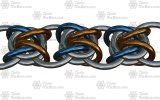
Base Weave:
Continuous Mirror Oblique - Odin's Eye
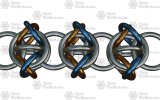
Continuous Layered Oblique - Also known as Odin's Eye
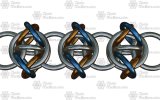
Base Weave:
Continuous Oblique - Byzantine Oblique
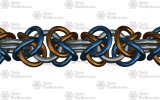
Conclusion
The preceding information should be enough to give you a solid foundation regarding the transformation known as an Oblique. As I've stated in previous articles, I'm not a textbook/technical writer and CCT is constantly evolving. What this means is that information/definitions in this article (and the previous one) are tentative. Changes may be made in the case of new discoveries, changes in understanding, and/or better definitions. In such cases, the new information will be posted in the associated discussion thread, as well as updated in the article. There is still more to come, including more "in depth" articles about some of the concepts presented.As always, if you have any questions or constructive criticism regarding CCT please feel free to let me know in the discussion thread for this article.

